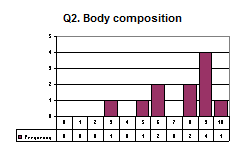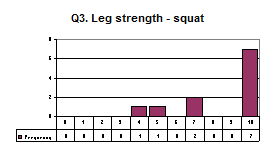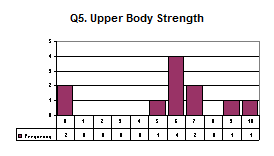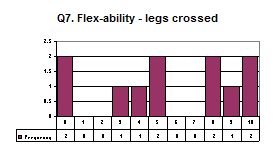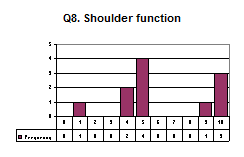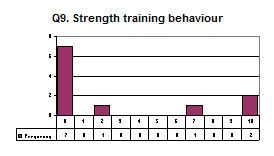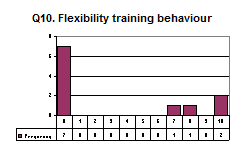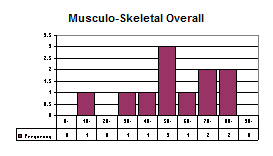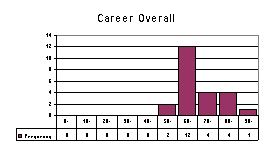
![]()
28. TSABK August 2012
John Miller conducted a Health Management program for The Group in August 2012.
23 people, 10 men and 13 women people completed the following profiles: -
■ Health, Fitness and Wellbeing
■ Musculo-skeletal risk
The results are presented in graphic format, with commentary.
HEATH CLIMATE SURVEY
The Health, Fitness and Wellbeing profile provides people with a very good idea of how well the various systems of the body are functioning, particularly the
the mind
autonomic nervous system
immune system
digestive system
circulatory system
elimination system
musculo-skeletal system.
On this profile, a good score is a low score. A poor score is a high score.
|
|
Symptom |
None |
Not much |
A fair bit |
A lot |
|||||||||
|
1. |
Headaches including migraines |
0 |
1 |
2 |
3 |
4 |
5 |
6 |
7 |
8 |
9 |
10 |
||
|
2. |
Lack of energy and vitality |
0 |
1 |
2 |
3 |
4 |
5 |
6 |
7 |
8 |
9 |
10 |
||
|
3. |
Candida - jock itch, thrush, tinea ... |
0 |
1 |
2 |
3 |
4 |
5 |
6 |
7 |
8 |
9 |
10 |
||
|
4. |
Poor sleep. If on tablets score 10 |
0 |
1 |
2 |
3 |
4 |
5 |
6 |
7 |
8 |
9 |
10 |
||
|
5. |
Snoring &/or sleep apnoea. Score 10 if using a mask |
0 |
1 |
2 |
3 |
4 |
5 |
6 |
7 |
8 |
9 |
10 |
||
|
6. |
Crook back, stiff neck, sore shoulders, dicky knee RSI ... |
0 |
1 |
2 |
3 |
4 |
5 |
6 |
7 |
8 |
9 |
10 |
||
|
7. |
Frequent colds, flu, sinus |
0 |
1 |
2 |
3 |
4 |
5 |
6 |
7 |
8 |
9 |
10 |
||
|
8. |
Unsettled stomach, reflux (Score 10 if on medication) |
0 |
1 |
2 |
3 |
4 |
5 |
6 |
7 |
8 |
9 |
10 |
||
|
9. |
Overweight - 1 point for every 2Kg |
0 |
1 |
2 |
3 |
4 |
5 |
6 |
7 |
8 |
9 |
10 |
||
|
10. |
Irritable bowel, constipation |
0 |
1 |
2 |
3 |
4 |
5 |
6 |
7 |
8 |
9 |
10 |
||
|
11. |
Asthma |
0 |
1 |
2 |
3 |
4 |
5 |
6 |
7 |
8 |
9 |
10 |
||
|
12. |
Low level of aerobic fitness |
0 |
1 |
2 |
3 |
4 |
5 |
6 |
7 |
8 |
9 |
10 |
||
|
13. |
Chest pain, palpitations |
0 |
1 |
2 |
3 |
4 |
5 |
6 |
7 |
8 |
9 |
10 |
||
|
14. |
Rashes, itchiness, skin outbreaks, psoriasis ... |
0 |
1 |
2 |
3 |
4 |
5 |
6 |
7 |
8 |
9 |
10 |
||
|
15. |
Mouth ulcers, cold sores |
0 |
1 |
2 |
3 |
4 |
5 |
6 |
7 |
8 |
9 |
10 |
||
|
16. |
Elevated blood pressure. Score 0 on pills |
0 |
1 |
2 |
3 |
4 |
5 |
6 |
7 |
8 |
9 |
10 |
||
|
17. |
Elevated blood cholesterol. Score o if on pills |
0 |
1 |
2 |
3 |
4 |
5 |
6 |
7 |
8 |
9 |
10 |
||
|
18. |
Elevated blood glucose. Score 0 if on medication |
0 |
1 |
2 |
3 |
4 |
5 |
6 |
7 |
8 |
9 |
10 |
||
|
19. |
Shakes, nervous ticks, mannerisms |
0 |
1 |
2 |
3 |
4 |
5 |
6 |
7 |
8 |
9 |
10 |
||
|
20. |
Grinding teeth |
0 |
1 |
2 |
3 |
4 |
5 |
6 |
7 |
8 |
9 |
10 |
||
|
21. |
Alcoholic drinks per day (2 pts/drink) |
0 |
1 |
2 |
3 |
4 |
5 |
6 |
7 |
8 |
9 |
10 |
||
|
22. |
Smoking. (1 pt/cigarette/day) |
0 |
1 |
2 |
3 |
4 |
5 |
6 |
7 |
8 |
9 |
10 |
||
|
23. |
Caffeine (1 pt/cup per day) |
0 |
1 |
2 |
3 |
4 |
5 |
6 |
7 |
8 |
9 |
10 |
||
|
24. |
Anxious about life, insecure, apprehensive |
0 |
1 |
2 |
3 |
4 |
5 |
6 |
7 |
8 |
9 |
10 |
||
|
25. |
Sad or depressed (On medication, score 0) |
0 |
1 |
2 |
3 |
4 |
5 |
6 |
7 |
8 |
9 |
10 |
||
|
26. |
In wrong job for now |
0 |
1 |
2 |
3 |
4 |
5 |
6 |
7 |
8 |
9 |
10 |
||
|
27. |
Under-appreciated at work |
0 |
1 |
2 |
3 |
4 |
5 |
6 |
7 |
8 |
9 |
10 |
||
|
28. |
Have poor work/life balance |
0 |
1 |
2 |
3 |
4 |
5 |
6 |
7 |
8 |
9 |
10 |
||
|
29. |
Unhappy with family life |
0 |
1 |
2 |
3 |
4 |
5 |
6 |
7 |
8 |
9 |
10 |
||
|
30. |
Unhappy with financial status |
0 |
1 |
2 |
3 |
4 |
5 |
6 |
7 |
8 |
9 |
10 |
||
|
Score |
The score of a normal, fit and healthy human being is less than 20
Higher scores are symptomatic of dysfunction of one or more body systems.
People with high levels of stress usually score well over 100.
For people with a score of more than 80, the background noise of their life is becoming louder and louder. It is hard to concentrate on your work when body systems are dysfunctional.
We know a fit and healthy group when we see the majority of scores below 40. This was not the case with this group. By and large higher scores are usually a reflection of
low levels of fitness
an inability to deal with what life and work are serving up to people.
Remember, it is not what happens, but how we deal with what happens that determines our level of stress.
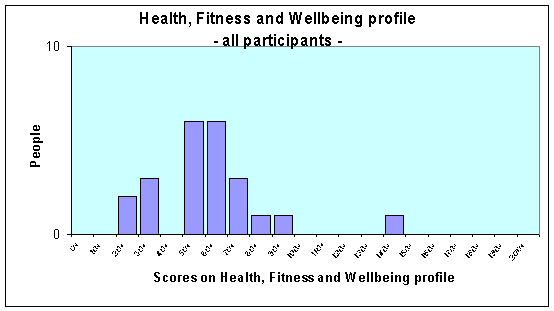
Classification of average scores: Excellent - less than 40. Good - 41 - 50. Fair 51-60. Poor - over 60.
This profile is described as poor. The average score was 61. Anyone scoring more than 80 is putting up with a lot of 'background noise'. It would be a wise move to take their holidays and long service leave and dedicate themselves to getting back into exceptionally good shape.
HEALTH CLIMATE SURVEY
Based on scores received in the Health, Fitness and Wellbeing profile we've compiled a Health Climate Survey. Scores on each item have ranked - the higher the score the worse the problem. We added the scores for each item. The results appear in the table below.
We registered those scores of 5 and over as being a symptom, issue or concern, the most pressing of which have been highlighted.
| Symptoms/ issues / concerns | % of people scoring over 5 | ||
|
Overweight |
52 | ||
|
Joint and muscle pain |
39 | ||
|
Financial status |
35 | ||
|
Lack of Energy |
30 | ||
|
Poor sleep |
30 | ||
|
Itchy, rashes, psoriasis |
30 | ||
|
Wrong job |
30 | ||
|
Elevated glucose |
26 | ||
|
Under appreciated at work |
26 | ||
|
Headaches |
22 | ||
|
Unhappy family life |
22 | ||
|
Snoring, sleep apnoea |
17 | ||
|
Frequent colds, flu, sinus |
17 | ||
|
Mouth ulcers |
17 | ||
|
Work-life balance |
17 | ||
|
Reflux, unsettled stomach |
13 | ||
|
Low level of fitness |
13 | ||
|
Grinding teeth |
13 | ||
|
Irritable bowel, constipation etc |
9 | ||
|
Shakes, nervous mannerisms |
9 | ||
|
Alcohol intake |
9 | ||
|
Anxious |
9 | ||
|
Candida |
4 | ||
|
Shortness of breath from asthma |
4 | ||
|
Elevated blood pressure |
4 | ||
|
Depressed |
4 | ||
|
Chest pain, palpitations |
0 | ||
|
Elevated cholesterol |
0 | ||
|
Smoking |
0 | ||
|
Caffeine |
0 |
Perception
Based on people's perception (where they gave a particular symptom a score of 5 or more, and backed up by objective scores) the key issues are
|
|
Obesity 52% of people said they were more than 10Kg over weight. It's a symptom of metabolic dysfunction and relates to high energy diets and low energy lifestyles. It's suggestive of elevated levels of insulin floating around the body, which is a precursor of all manner of body system dysfunctions - elevated blood pressure, elevated cholesterol, elevated blood glucose.
The recommendation, that people need to get more exercise (at lunch time) and eat from the top of the Hourglass. |
|
|
|
|
|
Lack of energy 30% of people said they lacked energy.
Low levels of energy come from many sources, including: - - lack of a good aerobic fitness training program - a diet high in wheat flour and sugar - dullness - ... |
|
|
|
|
|
Joint and muscle pain 39% of people said they had some sort of musculo-skeletal dysfunction.
Musculo-skeletal dysfunction goes with low levels of strength and flexibility. Those at greatest risk need encouragement to attend a strength and flexibility training program several Verdana a week. |
|
|
|
|
|
Rashes and itchiness 30% suffered from rashes and itchiness. Can be caused by a range of things: - - a body that's stressed producing too much cortisol - a toxic diet - a sluggish elimination system - itching to get away from something - ... |
|
|
|
|
|
Headaches 22% of people said they regularly get headaches. Headaches are caused by - a diet high in wheat flour and sugar - caffeine withdrawal - lack of oxygen getting to the head - a sluggish elimination system - a head out of alignment due to tight and weak muscles - beating your head against a brick wall - ... |
|
|
|
|
|
Under-appreciation at work 26% said they were under-appreciated at work. There's no excuse for that. |
|
|
|
|
|
Being in the wrong job
30% of people said they were in the wrong job. Why?
There is usually a high and positive correlation between people being in the wrong job and people saying they are under-appreciated at work. In this case this rule applied. |
MUSCULO-SKELETAL RISK FACTOR
Our musculo-skeletal risk factor profile looked at a range of parameters including mobility, strength and flexibility and whether people are training to keep themselves strong and flexible.
The musculo-skeletal risk factor profile is comprised of a mix of 7 objective and 3 subjective assessments.
Current musculo-skeletal condition
Closeness to ideal weight
Leg strength
Abdominal strength test
Upper body strength test
Flexibility
Functional mobility the ability to sit down and stand up with ease.
Shoulder function
Flexibility training behaviour
Strength training behaviour
Strength training behaviour
The 'pass mark' for each parameter is 7/10.
A score of 70% is readily attainable by those who have a regular and systematic training program.
|
|
| ||
|
Not a particularly good result. 45% of people are experiencing pain and discomfort. In a corporate setting we'd recommend that those scoring less the 6 need to be required attend a prehab/rehab program, for their own benefit and that of the organisation. |
20% of people were 15Kg or more overweight. I think a couple of people might have under estimated how over-weight they are! | ||
|
|
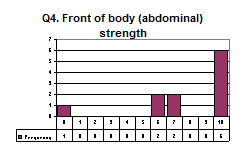 | ||
|
Leg strength was patchy. |
Overall, not a bad result. only 1 person couldn't do one situp. | ||
|
|
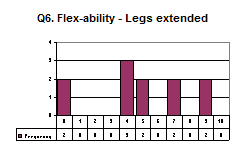 | ||
| Patchy, 25% of people failing the arm and upper body strength test. The best predictor of risk of lower back pain is the ability to do pressups. | 2 people couldn't touch their toes. Lower back pain goes with poor hamstring flexibility. | ||
|
|
| ||
| Around 50% of people couldn't sit up straight with legs crossed and hands clasped behind their back, without falling over. A major cause of lower back pain is tight buttock muscles. | Shoulder function was patchy, very patchy. It's redeemable with the right set of exercises. | ||
|
|
| ||
|
Its always the case, few people have a regular strength and flexibility program. The group needs to put in train a regular and systematic training program, on site, that includes
1. specialist prehab and rehab sessions for those at serious risk and those already dysfunctional and on compo
2. daily strength and flexibility sessions in the workplace for everyone. | |||
|
| |||
|
Average score: 58. Not particularly good. This graph show why people are experiencing pain. Too many people are not doing the things they need to do to keep their musculo-skeletal system in good shape. There is a strong case of the group to implement an obligatory strength and flexibility program for those who scored less than 60 in this profile. | |||
Those scoring less than 70 are not doing sufficient in the way of strength and flexibility exercises. They are therefore exposing themselves to a high risk of musculo-skeletal dysfunction. (It would be bizarre for a workplace to offer to pay the rehabilitation costs of people who were not keeping themselves strong enough or flexible enough to do their job without succumbing to musculo-skeletal dysfunction, wouldn't it?)
Lack of strength and flexibility is something that the Organisation needs to take seriously and monitor carefully and put in place an organisation-wide strategy to improve musculo-skeletal function. By far and away a high proportion of people do not have a strength and flexibility program. As a result they are getting weaker and tighter by the week, thereby exposing themselves and the organisation to risk.
When push comes to shove and people become dysfunctional, it will be The Organisation that ends up paying the high cost of an avoidable musculo-skeletal complaint.
In our opinion musculo-skeletal dysfunction caused by the lack of a regular and systematic strength and flexibility program cannot be classified as an injury. Responsibility for musculo-skeletal dysfunction needs to be sheeted home to individual employees, though its unlikely to happen without the establishment of a culture within the organisation that supports, values and understands strength and flexibility.
We recommend a range of strength and flexibility classes that are readily available Australia-wide: -
|
|
Posture and Flexibility |
|
|
Yoga |
|
|
Crookback Clinic |
|
|
Tai Chi |
|
|
Pontius Pilates |
The Organisation would place itself in the forefront of OH&S practice if it took the musculo-skeletal risk seriously and moved heaven and earth to educate all staff about this risk and encourage them to take part in a regular strength and flexibility program. Maybe The Organisation and its worker's compensation insurer could invest in a pilot program to increase staff strength and flexibility!
The lack of strength and flexibility training coupled with poor abdominal strength, upper body strength, flexibility and shoulder function is a cause for concern and needs the attention of individual staff and managers.
Recommendation
We strongly recommend that the people who are in current poor musculo-skeletal condition, and who lack abdominal strength, upper body strength, flexibility, shoulder function and functional mobility, in particular those who scored less than 60 on the profile, be obligated to attend regular, in-house strength and flexibility classes.
The pressure on the organisation's workers' compensation costs is such that to do otherwise would, in our opinion be to abrogate a responsibility for the prudent management of the organisation's finances.
CAREER SATISFACTION PROFILE
The parameters in the profile relate to a mix of factors influences by the participant, management and their colleagues.
How close are you to doing the job youd really like to be doing?
Are you in the right job for now?
Is work giving you life or sucking life out of you?
Are you focused on your career options?
Do you get good feedback from your manager?
Do you receive an appropriate financial reward?
Do you feel you and your work are valued and appreciated?
Do you work for an organisation that cares about people?
Do you enjoy the company of the people you work with?
Whats the level of morale like in your work group?
Normally, when results on the overall career profile are less than 70/100, people agree that theyre not in the right job. Certainly those scoring less than 60 have sufficient issues relating to career management as to seriously consider going somewhere else.
SCORING GUIDELINES
Excellent, scoring 8 or more
Good, scoring 7 or more
Fair, scoring 5 or 6
Poor, scoring less than 5
Pass mark on all parameters 7/10.
A good score is a high score. A poor score is a low score.
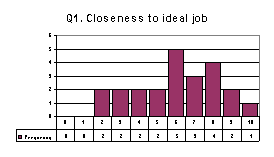 |
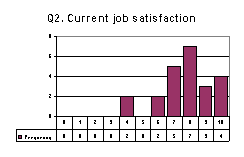 |
||
|
This is patchy result. Too many people are too far away from their ideal job. |
This is a good result. | ||
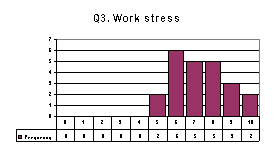 |
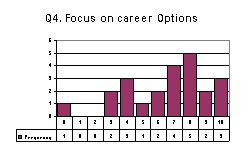 |
||
|
Another good result. Work is probably about as stressful as you want it to be. Walk away. Make appointments for your Self that allow you to get on with your work unhindered by interruptions. |
A fair to middling result. For those who scored 7/10 it didn't matter. |
||
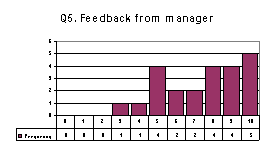 |
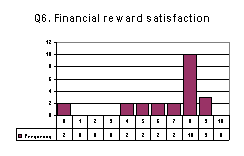 |
||
|
This is another fair to middling result. Of all our profile questions, this one is usually the worst answered. In this organisation there's some extra work for managers. For staff our recommendation is always to manage up. Take your manager out for morning tea once a month and talk about yourself and your work. Get some regular feedback. Don't wait for the big one at the end of the year. If you manager doesn't have time for you, get another one! |
With a few exceptions, these people are pretty satisfied with what they sell themselves for. |
||
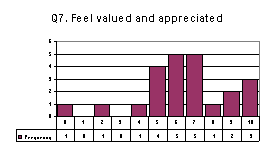 |
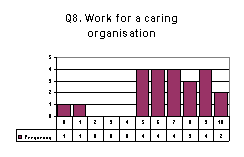 |
||
|
A good result is when everyone gets over 7/10. You can't call this a good result. |
This is a patchy score. The aim is to have all staff recording a score of 7 or more. |
||
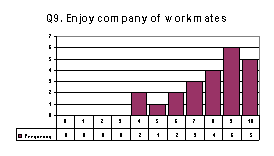 |
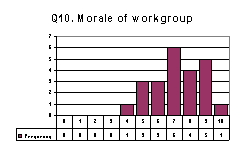 |
||
| This is a good score. People like working with each other. | Morale is pretty good, but not fantastic. It's generally the case that our morale is good when my morale is good. | ||
|
|
|||
|
Average score: 70. Compared with other groups, this result is a bit off the pace. For those who scored less than 70, there is the whiff of a suggestion they're not in the right job. The situation is certainly redeemable. |
|||
The Buddha and Confucius both said 'Find the job you'd love to do and you don't have to do another days work in your life.'

